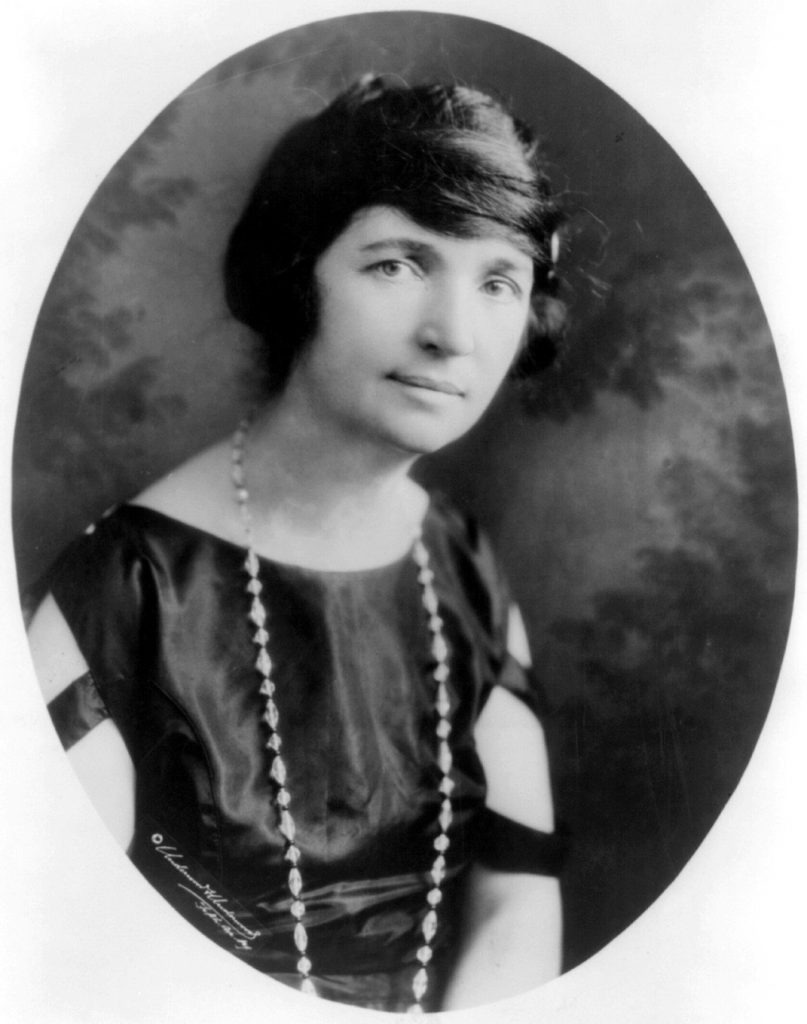Women have proven to be influential when it comes to social reform. During the 1920’s, women began to bob their hair, shorten their skirts, and voice their disdain for various restrictions on women. One of those restrictions involved women’s reproductive health. Margaret Sanger was a pioneer in women’s rights for birth control. Sanger wasn’t afraid to stand up for what she believed in, even if that meant speaking up when the subject was taboo. She was able to help twentieth-century women to gain the right to decide when and if they were to have children. Sanger sought to influence societal norms and cultural beliefs, which have ultimately changed the lives of millions of women to this day.
The 1920s was an eventful decade for women. Not only did women receive the vote, but they also broke longstanding traditions, epitomized by the image of the “flapper.” F. Scott Fitzgerald described the “flappers” of the day as “lovely, expensive, and about nineteen.”1 The flapper attitude was characterized by blunt truth, fast living, and sex. They were seen as reckless and lived in the moment. Most of this, if not all of the behavior was due to World War I. During this time period, men joined the war effort, and women joined the workforce, receiving a paycheck and having disposable wealth, which women used to express their independence. After the war ended, both genders found it difficult to return to society’s previous structure.

“They found themselves expected to settle down into the humdrum routine of American life as if nothing had happened, to accept the moral dicta of elders who seemed to still be living in a Pollyanna land of rosy ideals which the war had killed for them.”2 Before the society’s social structure underwent a transformation, women didn’t necessarily date; they were supposed to wait for a proper suitor to pay them interest, as long as their intentions were good. What once had been “proper” social values were going through changes. One flapper in particular that exemplified these changing values was Margaret Sanger.
On September 14, 1879, Michael Hennessy Higgins and Anne Purcell Higgins gave birth to not only their sixth child (of eleven), but one of the most influential birth-control activists this country has ever known. Aside from the influence growing up with ten siblings, Sanger was also exposed to most of her parents’ Roman Catholic beliefs. After her mother’s death at age fifty, her father relinquished his own Roman Catholic beliefs, and became an atheist. In becoming an atheist, Michael Higgins not only changed his personal views but the views of his children, all the while becoming an activist for women’s suffrage. The views of those who raised her (mainly her father), as well as her personal experiences, helped mold her personal views on sex issues, feminism, and ultimately birth control.3
Shortly after that, during her earlier career, Sanger practiced nursing in the destitute areas of the East Side of New York City. In her nursing career, Sanger was exposed to a high level of poverty that included exposure to poor families, and to women that had frequent childbirths, miscarriages, and abortions. During this time working, she started writing educational columns for women, including “What Every Mother Should Know,” and she helped many women who wished to terminate their pregnancies.4 In her experience with the often hidden aspects of child-bearing, Sanger determined the principal focus of her activism: birth control. Because of the things she witnessed, Sanger decided to take the next step in her activism. In March 1914, Sanger published The Woman Rebel, a newspaper that was devoted to educating and raising the consciousness of working women. “This journal was used to assert that every woman has the right to be an ‘absolute mistress of her own body’ including the right to practice birth control.”5
In April 1914, Sanger was notified by the postal authorities that she had violated obscenity laws due to her newspaper. The following May, she declared to the public that The Woman Rebel was “not going to be suppressed by the post office until it has accomplished the work which it has undertaken.”6 Three months later Sanger was formally indicted for violating the Federal Comstock Law. To avoid the risk of spending twenty years in jail, Sanger got on a train to Canada, acquired a false passport, and sailed to England under the name “Bertha Watson.”7 By 1915, after her actions caught the attention of many, Sanger returned to New York to stand trial. Within a few months, her five year old daughter Peggy died of pneumonia. Due to her loss, many expressions of sympathy poured in, and many friends and supporters sent letters and petitions to President Wilson, affirming their support for Sanger.8 With the newly intensified coverage that The Woman Rebel case and the birth control movement had received, to avoid further publicity, the government decided not to press charges.9

Brownsville, New York | Courtesy of Margaret Sanger Papers Project
With this newfound publicity due to The Woman Rebel scandal, Sanger was able to found the first birth control clinic in the United States, on October 15, 1916 in Brownsville, New York. There were some supporters, but others raised their voices against her. Nine days after the grand opening, there was a police raid, and all of the clinic staff (including Margaret Sanger herself) were arrested and prosecuted. In managing these arrests and prosecutions, New York City’s police department may have done more bad than good. Due to the amount of news coverage the arrests made, there were multiple benefactors willing to bail Sanger out, as well as fund the organization. With the newfound publicity, during the month of February 1917, Sanger was able to publish the first issue of her journal, The Birth Control Review.[10. Caroline Katzive, “Margaret Sanger: Demonstrating Leadership and Legacy Through Her Crusade For Women’s Reproductive Rights,” History Teacher 49, no. 1 (November 2015): 130.] She was its editor until 1929, and used her editorials to promote birth control and negative eugenics. “Eugenists emphasize the mating of healthy couples for the conscious purpose of producing healthy children, the sterilization of the unfit to prevent their populating the world with their kind and they may, perhaps, agree with us that contraception is a necessary measure among the masses of the workers, where wages do not keep pace with the growth of the family and its necessities in the way of food, clothing, housing, medical attention, education and the like.”10
Sanger was known for her controversial views. She once proposed allowing Congress to solve “population problems” by appointing a “Parliament of Population.” “Directors representing the various branches of science [in the Parliament would] … direct and control the population through birth rates and immigration, and direct its distribution over the country according to national needs consistent with taste, fitness and interest of the individuals.”11 One interesting view in particular Sanger had, was the way she differentiated “Eugenists” and “Birth Control Advocates.”
We who advocate Birth Control, on the other hand, lay all our emphasis upon stopping not only the reproduction of the unfit but upon stopping all reproduction when there is not economic means of providing proper care for those who are born in health. The eugenist also believes that a woman should bear as many healthy children as possible as a duty to the state. We hold that the world is already over-populated. Eugenists imply or insist that a woman’s first duty is to the state; we contend that her duty to herself is her duty to the state.12
By this point in time, Sanger had made many of the accomplishments toward reaching her initial goals. On November 10, 1921, Sanger founded the American Birth Control League (ABCL) in New York City. She established ABCL to offer an ambitious program of education, legislative reform, and research. Her goal was to build a truly national organization with representation in every region of the country.13

In 1942, The American Birth Control League became the Planned Parenthood Federation of America.14 Even after the name change, the organization continued to strive. It seems as though Sanger knew just which stepping stones it took to reach her goals all the while never straying away from her views on eliminating the unfit.
Throughout her lifetime, Sanger was able to influence many. Not all of the impact during her time as an advocate for women’s issues was positive, considering her highly controversial views. Compared to the way society was when her activism began in the 1920’s, the country’s relationship with birth control has altered substantially. Sanger’s goal was to build a national organization with representation in every region of the country. Today, “Planned Parenthood is one of the nation’s leading providers of high quality health care…and the nations largest provider of sex education…Planned Parenthood has 56 undefended local affiliates that operate nearly 650 health centers throughout the United States.”15 The views of Margaret Sanger inspired the availability of reproductive health care for women across the nation. Sanger started a process in which her actions ignited a series of changes in societal norms. On September 14, 1879 Michael Hennessy Higgins and Anne Purcell Higgins gave birth to not only a revolutionist, but to the creator of the legacy that continues to be Planned Parenthood.16
- St. James Encyclopedia of Popular Culture, 2000, s.v. “Flappers,” by Jackie Hatton. ↵
- Frederick Allen, Only Yesterday: An Informal History of the Nineteen-Twenties (New York: Harper & Brothers Publishers, 1931), 94-95. ↵
- Salem Press Biographical Encyclopedia, January 2016, s.v. “Margaret Sanger,” by Lesley Croft. ↵
- Salem Press Biographical Encyclopedia, January 2016, s.v. “Margaret Sanger,” by Lesley Croft. ↵
- Caroline Katzive, “Margaret Sanger: Demonstrating Leadership and Legacy Through Her Crusade For Women’s Reproductive Rights,” History Teacher 49, no. 1 (November 2015): 128. ↵
- Margaret Sanger, “The Woman Rebel,” The Ban, (May 1914.): 1 ↵
- Caroline Katzive, “Margaret Sanger: Demonstrating Leadership and Legacy Through Her Crusade For Women’s Reproductive Rights,” History Teacher 49, no. 1 (November 2015): 128-129. ↵
- Caroline Katzive, “Margaret Sanger: Demonstrating Leadership and Legacy Through Her Crusade For Women’s Reproductive Rights,” History Teacher 49, no. 1 (November 2015): 129-130. ↵
- Caroline Katzive, “Margaret Sanger: Demonstrating Leadership and Legacy Through Her Crusade For Women’s Reproductive Rights,” History Teacher 49, no. 1 (November 2015): 129-130. ↵
- Margaret Sanger, “Birth Control and Racial Betterment,” The Birth Control Review (April 1919): 11-12. ↵
- Margaret Sanger, “A Plan for Peace,” The Birth Control Review (April 1, 1932): 107-108. ↵
- Sanger, “Birth Control and Racial Betterment,” The Birth Control Review (April 1919): 11-12. ↵
- Caroline Katzive, “Margaret Sanger: Demonstrating Leadership and Legacy Through Her Crusade For Women’s Reproductive Rights,” History Teacher 49, no. 1 (November 2015): 131. ↵
- Salem Press Biographical Encyclopedia, January 2016, s.v. “Margaret Sanger,” by Lesley Croft. ↵
- Planned Parenthood, “Planned Parenthood at a Glance,” Planned Parenthood, (March 2017): https://www.plannedparenthood.org/about-us/who-we-are/planned-parenthood-at-a-glance/ ↵
- Caroline Katzive, “Margaret Sanger: Demonstrating Leadership and Legacy Through Her Crusade For Women’s Reproductive Rights,” History Teacher 49, no. 1 (November 2015): 132. ↵



46 comments
Gabriel Lopez
This article is great at explaining the background of Sanger and how she started Planned Parenthood. I do admit that it is very brave of her to stand up for such a controversial topic, which it still is even in today’s society. Personally, I don’t support Planned Parenthood and most of their visions, but it was still a good informative article.
Alicia Guzman
The topic of Planned Parenthood has become like the article mentions, a very “taboo” and controversial topic in the United States often triggering deep-seated opinions. This article does a wonderful job of providing a comprehensive background on Sanger including the loss of her mother at a young age along with the effects it had on her family. While Sanger has had wonderful ideas, like everything else in life there have been some bad ones too.
Danniella Villarreal
This was a good informative article, and a very nice read. I personally completely support the idea of planned parenthood. It helps young adults who have no one to turn to. Although it is true that some of her views may be controversial even by today’s standards she was right when she said that women should be able to control their future. I also like the fact that they changed their name. It shows growth.
Yazmin Garza
It makes sense that such a passionate person was the founder of Planned Parenthood. Only a very strong person would be able to consistently fight against such an established way of thinking. I am glad Sanger was inspired enough to speak out and brave enough to risk being arrested and thrown in jail to provide women with all the options available. I’m also glad that her father decided to become an atheist because if Sanger had been in a religious household, she probably wouldn’t have been able to develop her own way of thinking about reproductive rights.
Christopher Hohman
Nice article. Margaret Sanger was quite an extraordinary person. Although it is true that some of her views may be controversial even by today’s standards she was right when she said that women should be able to control their destiny especially in regard to the number of children they have. Sometimes birth control is necessary because families cannot provide for their children. In that case I believe it is right to use some form of contraception.
Madison Downing
I completely support the idea of Planned Parenthood and I don’t believe that they should be shut down. Birth control is what keeps young people from making mistakes and bring a child into the world that would not be able to be properly cared for. I had no idea that Planned Parenthood is not even that old of an organization and it is crazy 50 years ago (maybe a little more) that this organizations would just be started up. You did an amazing job and this was a wonderful article!
Emily Jensen
Very informative article, a great read! I didn’t know any of the history behind Planned Parenthood prior to reading this article, the author did a great job at explaining all the history of the organization. Birth control is a controversial topic even today, I can understand why they changed their name from The American Birth Control League to Planned Parenthood, a less tendentious title.
Maria Mancha
I love women rights, its one of my favorite things. I had never researched the origins of planned parenthood. Birth control in its self is a beyond controversial conversation. I think I really enjoyed how even though she was arrested she didnt give up her fight and its people like her who don’t give up for their rights that will make this country truly equal. Margaret Sanger is a hero, she’s a leader, and a role model to people, especially women all over the world. Even though people told her she was wrong for what she was doing, even if she was seen as a “flapper”. Planned Parenthood and birth control are used for so many different reasons than just sex and abortions. There is so much more to it and I am extremely thankful for Margaret Sanger. As well as I truly loved your article and how you helped us all learn more about this women and Planned Parenthood.
Natalia Flores
What a great article about one of the most controversial topics in modern history! It really delved into the story of Margaret Sanger and brought to light how slanted policies were. It’s amazing that men thought that after going to war and after women had gotten jobs and a life outside the home they would willingly go back to that. I had no idea that she wanted a population branch in Congress!
Clayton Trevino
It’s great to see that we’ve come from a time where birth control was universally considered to be taboo to a point where birth control and contraceptives are relatively cheap and easily available for responsible adults. In my experience, I find that those on the right are not against planned parenthood providing birth control/contraceptives, but instead disagree with the number of abortions performed by planned parenthood on an annual basis. This practice is not the type of empowerment that I believe Margaret Sanger wished to portray.